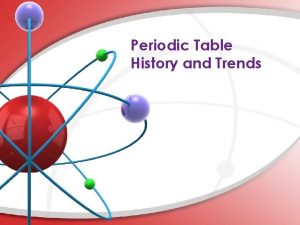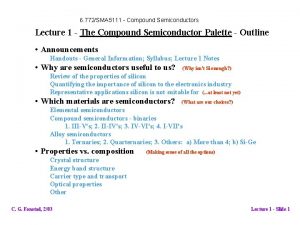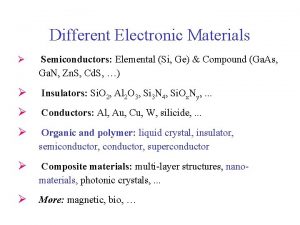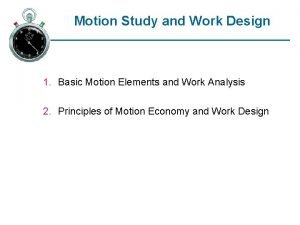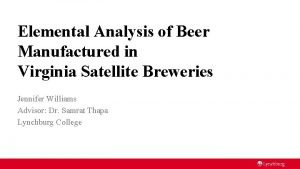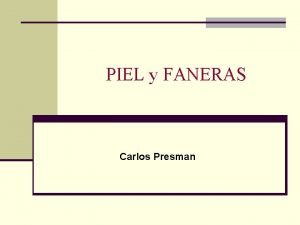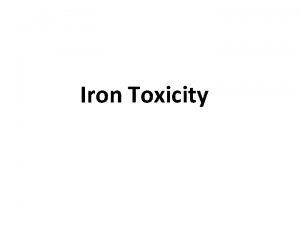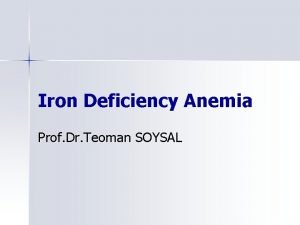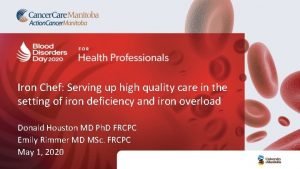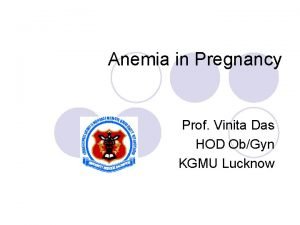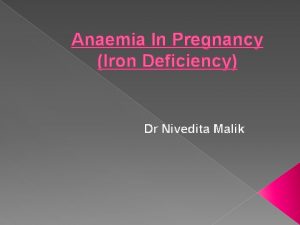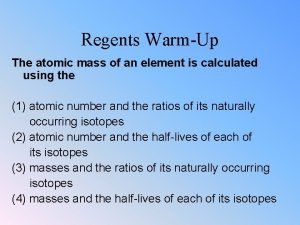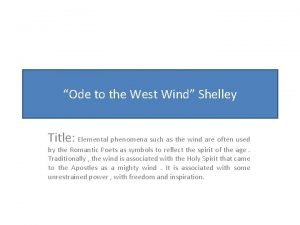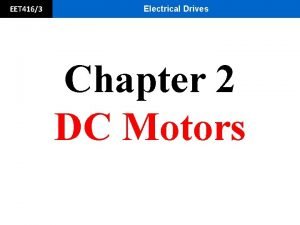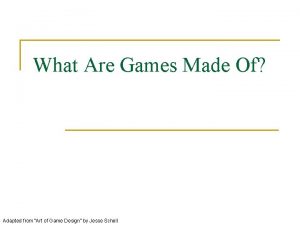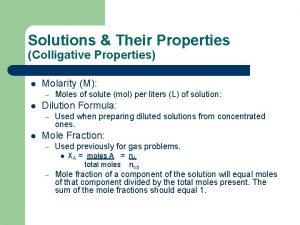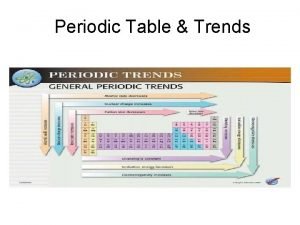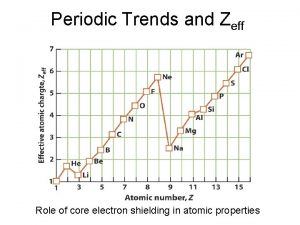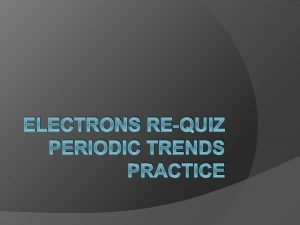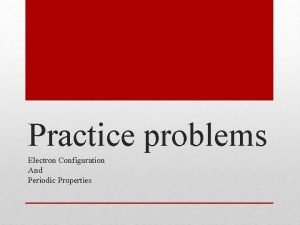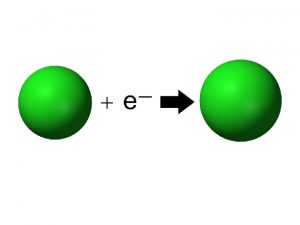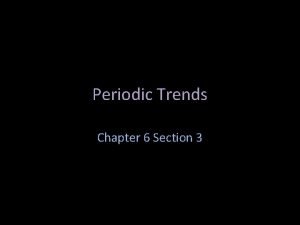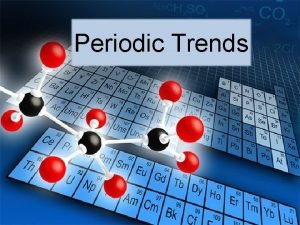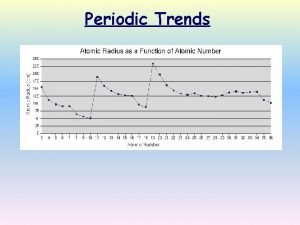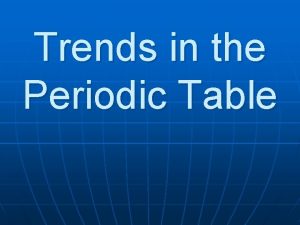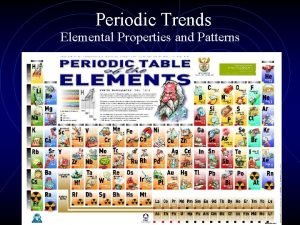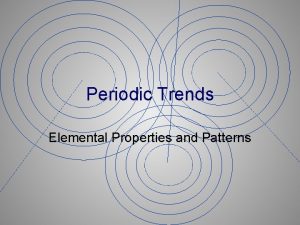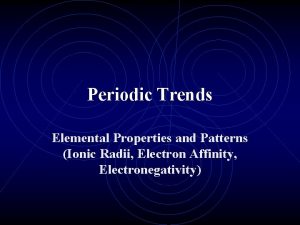Periodic Trends Elemental Properties and Patterns The Periodic

























































- Slides: 57

Periodic Trends Elemental Properties and Patterns

The Periodic Law • Dimitri Mendeleev was the first scientist to publish an organized periodic table of the known elements.

The Periodic Law • Mendeleev even went out on a limb and predicted the properties of 2 at the time undiscovered elements. • He was very accurate in his predictions, which led the world to accept his ideas about periodicity and a logical periodic table.

Mendeleev’s Prediction

• Mendeleev arranged the elements by increasing atomic mass. • The modern periodic table is in order of increasing atomic number. • Mosley is given credit for arranging by atomic number.

The Periodic Law • When arranged by increasing atomic number, the chemical elements display a regular and repeating pattern of chemical and physical properties.

The Periodic Law • Atoms with similar properties appear in groups or families (vertical columns) on the periodic table. • They are similar because they all have the same number of valence (outer shell) electrons, which governs their chemical behavior.

Valence Electrons • Do you remember how to tell the number of valence electrons for elements in the s- and p-blocks? • How many valence electrons will the atoms in the d-block (transition metals) and the fblock (inner transition metals) have? • Most have 2 valence e-, some only have 1.

A Different Type of Grouping • Besides the 4 blocks of the table, there is another way of classifying elements: • Metals • Nonmetals • Metalloids or Semi-metals

Metals, Nonmetals, Metalloids • There is a zig-zag or staircase line that divides the table. • Metals are on the left of the line, in blue. • Nonmetals are on the right of the line, in orange.

Metals, Nonmetals, Metalloids • Elements that border the stair case, shown in purple are the metalloids or semimetals. • There is one important exception. • Aluminum is more metallic than not.

Metals • Metals are lustrous (shiny), malleable, ductile, and are good conductors of heat and electricity. • They are mostly solids at room temp. • What is one exception? • Hg

Nonmetals • Nonmetals are the opposite. • They are dull, brittle, nonconductors (insulators). • Some are solid, but many are gases, and bromine is a liquid.

Metalloids • Metalloids, aka semi-metals are • • • just that. They have characteristics of both metals and nonmetals. They are shiny but brittle. They are semiconductors. What is our most important semiconductor? Si

Reactivity of Alkali Metals • https: //www. youtube. com/watch? v=UO 0 C KJ 0 ubw. M

Good Afternoon! • You will need your notes, reference packet, and last night’s homework

Periodic Trends

Important Concepts outermost • Valence electrons- electrons in the ______ energy level inner • Core electrons- electrons in the ____ energy levels • When an atom loses an electron, which electron is removed? valence

Effective Nuclear Charge (Zeff) • What keeps electrons from simply flying off into space? • Effective nuclear charge is the pull that an electron “feels” from the nucleus. • The closer an electron is to the nucleus, the more pull it feels. (Higher Zeff) • As effective nuclear charge increases, the electron cloud is pulled in tighter.

Shielding Effect • The core electrons in an atom “shield” the valence electrons from the pull of the nucleus • As the shielding increases (more e- between nucleus and valence e-), the effective decreases nuclear charge _____.

Sodium and Potassium

Applications • • Which atom (Na or K) is a larger atom? Why? More energy levels Which atom has more shielding? K Which atom has a higher effective nuclear charge? Na • Which atom would require less energy to remove the valence electron? (easiest to remove) K

Atomic Radius (Size) • The trend for atomic radius in a vertical column is to go from smaller at the top to larger at the bottom of the family. Increases down the group. • Why? • With each step down the family, we add an entirely new energy level to the electron cloud, making the atoms larger.

Atomic Radius • The trend across a horizontal period is less obvious. • What happens to atomic structure as we move from left to right across a period? • Each step adds a proton and an electron (and 1 or 2 neutrons). • Electrons are added to existing energy levels or sublevels.

Atomic Radius • The effect is that the more positive nucleus has a greater pull on the electron cloud. • The nucleus is more positive and the electron cloud is more negative. • The increased attraction pulls the cloud in, making atoms smaller as we move from left to right across a period. • The Zeff increases but the shielding does not change.

Atomic Radius decreases increases

Practice 1. Arrange the following in order of increasing size: A) O, Se, S O, S, Se B) P, Mg, Cl Cl, P, Mg C) S, F, Rb F, S, Rb D) P, Ga, O O, P, Ga

Ionization Energy • This is the second important periodic trend. • If an electron is given enough energy (in the form of a photon) to overcome the effective nuclear charge holding the electron in the cloud, it can leave the atom completely. • The atom has been “ionized” or charged. • The number of protons and electrons is no longer equal.

Ionization Energy • The energy required to remove an electron from an atom is ionization energy. (measured in kilojoules, k. J) • The larger the atom is, the easier its electrons are to remove. • Ionization energy and atomic radius are inversely proportional. • Ionization energy is always endothermic, which means energy is added to the atom to remove the electron.

Ionization Energy • As you move down a group, the ionization energy decreases. It becomes easier to remove the valence electron. • Why? Bigger atom -> less Zeff -> more shielding • As you move across a period, the ionization energy increases. • Why? Smaller atom -> more Zeff -> less shielding

Ionization Energy increases decreases

Exceptions (Honors) *does not vary uniformly across period* • 2 nd period in order of increasing I. E. • Li, Be, C, Why? O, N, F, Ne

Practice 1. Arrange in order of increasing ionization energy: A) Br, Cl, I I, Br, Cl B) Sb, Sr, I Sr, Sb, I C) (Honors) Ge, As, Se Ge, Se, As

Electron Affinity (Honors) - Electronegativity • What does the word ‘affinity’ mean? • Electron affinity is the energy change that occurs when an atom gains an electron (also measured in k. J). • Where ionization energy is always endothermic, electron affinity is usually exothermic, but not always.

Electron Affinity (Honors) • Electron affinity is exothermic if there is an empty or partially empty orbital for an electron to occupy. • If there are no empty spaces, a new orbital or energy level must be created, making the process endothermic. • This is true for the alkaline earth metals and the noble gases.

Electron Affinity increases decreases Do not include the noble gases!

Metallic Character (Activity of Metals) • Which family of metals would be the most reactive? Alkali Metals • Why? • As you move down a group, the activity of metals increases. • As you move across a period, the activity of metals decreases.

Activity of Metals • The activity of metals is based on how easily the metal loses an electron. • Very active metals lose their valence electrons easily.

Activity of Metals decreases increases

Examples 1. What is the most active metal: A) Ca, Be, Sr B) Sc, K, Ca K C) Pd, Cd, Sr

Nonmetallic Character (Activity of Nonmetals) • What family is the most active of the nonmetals? • Why? • As you move down a group, the activity of nonmetals decreases. • As you move from left to right across a period, the activity of nonmetals increases. • What is the most active nonmetal? F

Activity of Nonmetals • The activity of nonmetals is based on how easily an atom will gain an electron. • Very active nonmetals have a strong attraction for electrons.

Activity of Nonmetals increases decreases Do not include the noble gases!

Way To Remember The Trends What trends increase down a group and decrease across a period? decrease increase size, activity of metals


What is the Name of the Snowman? Size Activity of Metals

Good Afternoon! • You will need your homework, note packet, and reference packet

Ionic Radius • Cations are always smaller than the original atom. • The valence electrons are removed during • • ionization. Ca 2+ is ______than Ca. Conversely, anions are always larger than the original atom. Electrons are added to the outer energy level. S 2 - is _______than S.

Cation Formation Effective nuclear charge on remaining electrons increases. Na atom 1 valence electron 11 p+ Valence e- lost in ion formation Result: a smaller sodium cation, Na+ Remaining e- are pulled in closer to the nucleus. Ionic size decreases.

Anion Formation Chlorine atom with 7 valence e 17 p+ One e- is added to the outer shell. Effective nuclear charge is reduced and the e- cloud expands. A chloride ion is produced. It is larger than the original atom.

Examples 1. Arrange from smallest to largest: A) H, H+, H- H+, H, HB) K+, Cl-, S-2, Ca+2, K+, Cl-, S-2 2. Given the following elements, which would be the largest when forming an ion? Br, Se, Rb, Sr Se (Se-2)

Periodic Table Song https: //www. youtube. com/watch? v=Vg. VQKC cfwn. U&list=PLJr. I 7 At. Iq. GQQYegg. VPRZQx. E ILch. YTSc. ZH&index=42

Ionization Energy (Honors) • First Ionization Energy – the energy required to remove 1 valence electron. • Second Ionization Energy – the energy required to remove 2 valence electrons. • Third Ionization Energy – remove 3 electrons

Ionization Energy • Once the valence electrons are removed, it becomes very difficult to remove the electrons.

Ionization Energy

Ionization Energy 1. Which atom would have a large increase between the 1 st and 2 nd ionization energies? A. Sr B. Ga C. Li Li

Ionization Energy 2. Where would there be the biggest increase in ionization energies? A. Ca 2 nd and 3 rd B. Si 4 th and 5 th C. K 1 st and 2 nd
 Nuclear charge definition
Nuclear charge definition Periodic trends in elemental properties
Periodic trends in elemental properties Periodic trends in elemental properties
Periodic trends in elemental properties Trends of the periodic table
Trends of the periodic table Periodic trends in properties of elements
Periodic trends in properties of elements Alien periodic table periodic trends answers
Alien periodic table periodic trends answers A visual aid used to show statistical trends and patterns.
A visual aid used to show statistical trends and patterns. A visual aid used to show statistical trends and patterns
A visual aid used to show statistical trends and patterns Elemental and compound semiconductors
Elemental and compound semiconductors Elemental and compound semiconductors
Elemental and compound semiconductors Closed patterns and max-patterns
Closed patterns and max-patterns How understanding of motion elements and principles
How understanding of motion elements and principles Elemental analysis of beer
Elemental analysis of beer Unidad elemental
Unidad elemental Verruga vulgar
Verruga vulgar Elemental iron dose
Elemental iron dose Siderobl
Siderobl Elemental iron dose
Elemental iron dose Elemental enteral nutrition
Elemental enteral nutrition Características del movimiento en educación física
Características del movimiento en educación física Complications of anemia
Complications of anemia Elemental iron dose
Elemental iron dose Elemental states
Elemental states Que es la gimnasia elemental
Que es la gimnasia elemental Elemental balance in bioprocess
Elemental balance in bioprocess Elemental balance in bioprocess
Elemental balance in bioprocess Ode to the elemental rainbow
Ode to the elemental rainbow Pediasure cpt code
Pediasure cpt code Masas polares alternador
Masas polares alternador Difference between fleming right and left hand rule
Difference between fleming right and left hand rule Gimnasia elemental
Gimnasia elemental Elemental tetrad
Elemental tetrad Elemental analysis of an unknown pure substance
Elemental analysis of an unknown pure substance Ionization radius
Ionization radius Atom size trend periodic table
Atom size trend periodic table Electronegativity trend
Electronegativity trend Periodic table basics
Periodic table basics Oxygen periodic trends
Oxygen periodic trends Graphing periodic trends
Graphing periodic trends Oxidation trends periodic table
Oxidation trends periodic table Electronegativity meaning
Electronegativity meaning Zeff trend in periodic table
Zeff trend in periodic table Periodic trends activity worksheet
Periodic trends activity worksheet Periodic trends practice quiz
Periodic trends practice quiz Periodic trends in reactivity
Periodic trends in reactivity Periodic trends summary
Periodic trends summary Electron practice problems
Electron practice problems Electron affinity worksheet
Electron affinity worksheet Electron affinity trends
Electron affinity trends All periodic trends
All periodic trends Atomic radus
Atomic radus Atomic radius definition
Atomic radius definition Periodic trends acidity
Periodic trends acidity Periodic table trends
Periodic table trends Periodic table trends
Periodic table trends Periodic table with properties
Periodic table with properties Periodic trends game
Periodic trends game Periodic trends definition
Periodic trends definition




